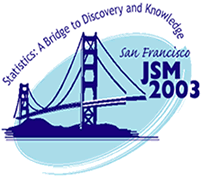|
Activity Number:
|
296
|
|
Type:
|
Contributed
|
|
Date/Time:
|
Tuesday, August 5, 2003 : 2:00 PM to 3:50 PM
|
|
Sponsor:
|
Biopharmaceutical Section
|
| Abstract - #300736 |
|
Title:
|
Acceptance Criteria for External Standards that Improve Calibration Results for Quantitative RT-PCR Assays
|
|
Author(s):
|
Inna Chervoneva*+ and Terry Hyslop and Boris Iglewicz
|
|
Companies:
|
Thomas Jefferson University and Thomas Jefferson University and Temple University
|
|
Address:
|
125 South 9th Street, #402, Philadelphia, PA, 19107,
|
|
Keywords:
|
global two-stage estimation ; nonlinear mixed effects model ; polymerase chain reaction ; quality control ; REML ; standard curve calibration
|
|
Abstract:
|
Quantitative reverse transcription polymerase chain reaction (Q-RT-PCR) is a novel technology that enables one to determine the copy number of mRNA molecules. Commercial instruments utilize standard curves to calibrate unknown samples. This method is predicated on the assumption that efficiency of the reaction is the same for all external standards and samples. When this is not the case, the calibration errors might be very high. We develop acceptance criteria for standards to be used as a part of the standard curve. We use Q-RT-PCR kinetic data to estimate the maximum amplification rate for each standard and model this rate as a function of concentration and random effects of plate and well on the plate. We use a global two-stage method, which incorporates the uncertainty of estimating well-specific amplification rates, but instead of the previously developed ML approach we propose a REML approach. The standardized residuals of this model are used to detect and exclude outliers with low amplification efficiency. The proposed procedure is applied to data from the analytical validation study of guanylyl cyclase-C assay, demonstrating a dramatic reduction in calibration errors.
|
